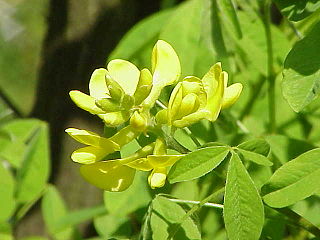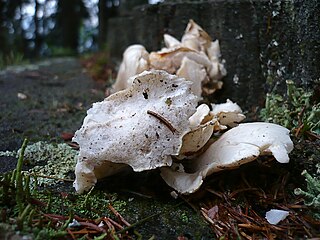
The Cantharellaceae are a family of fungi in the order Cantharellales. The family contains the chanterelles and related species, a group of fungi that superficially resemble agarics but have smooth, wrinkled, or gill-like hymenophores. Species in the family are ectomycorrhizal, forming a mutually beneficial relationship with the roots of trees and other plants. Many of the Cantharellaceae, including the chanterelle, the Pacific golden chanterelle, the horn of plenty, and the trumpet chanterelle, are not only edible, but are collected and marketed internationally on a commercial scale.

Petteria ramentacea, commonly known as Dalmatian laburnum, is a species of flowering plant in the family Fabaceae. It is a deciduous shrub native to the western Balkan Peninsula, including Greece, Albania, Bosnia and Herzegovina, and Montenegro. It grows up to 3 meters tall, and flowers in May. It grow in shrubland and scrub from 10 to 700 meters elevation, in both sub-Mediterranean and Mediterranean habitats. It belongs to the subfamily Faboideae. It is the only member of the genus Petteria.
UK hard house or simply hard house is a style of electronic dance music that emerged in the early 1990s and is synonymous with its association to the Trade club and the associated DJs there that created the style. It often features a speedy tempo, offbeat bass stabs, hoovers and horns. It usually contains a break in the middle of the track where no drums are present. UK hard house often uses a long and sharp string note to create suspense. Most of the time, the drops are introduced by a drum roll.

This is a list of the properties on the National Register of Historic Places in Broome County, New York, taken from the National Register of Historic Places for Broome County.

Antrodia albida is a species of fungus in the genus Antrodia that grows on the dead wood of deciduous trees. A widely distributed species, it is found in Africa, Asia, Europe, Oceania, North America, and South America. The fungus was first described under the name Daedalea albida by Elias Magnus Fries in his 1815 work Observationes mycologicae. Marinus Anton Donk transferred it to Antrodia in 1960.

Rigidoporus is a genus of fungi in the family Meripilaceae. Many of the species in this genus are plant pathogens. The widespread genus, which contains about forty species, was originally circumscribed by American mycologist William Alphonso Murrill in 1905. The generic name combines the Latin word rigidus ("rigid") with the Ancient Greek word πόρος ("pore").

The Fomitopsidaceae are a family of fungi in the order Polyporales. Most species are parasitic on woody plants, and tend to cause brown rots. The name comes from Fomitopsis + -aceae.

Fomitopsis is a genus of more than 40 species of bracket fungi in the family Fomitopsidaceae.

Antrodia is a genus of fungi in the family Fomitopsidaceae. Antrodia species have fruit bodies that typically resupinate, with the hymenium exposed to the outside; the edges may be turned so as to form narrow brackets. Most species are found in temperate and boreal forests, and cause brown rot.

Ceriporia is a widely distributed genus of crust fungi.

Osteina is a fungal genus in the family Dacryobolaceae.

Coriolopsis is a genus of fungi in the family Polyporaceae. It was circumscribed by American mycologist William Alphonso Murrill in 1905. The genus is cosmopolitan, with most species in tropical areas. The generic name combines the name Coriolus with the Ancient Greek word ὄψις ("appearance").

Datronia is a genus of poroid crust fungi in the family Polyporaceae. The genus was circumscribed by Marinus Anton Donk in 1966, with Datronia mollis as the type species. Datronia fungi cause a white rot in hardwoods. Datronia contains six species found in northern temperate areas. The most recent addition, Datronia ustulatiligna, was described in 2015 from Himachal Pradesh in India.
Episphaeria is a genus of fungus in the Agaricales. The genus is monotypic, and contains the single rare species Episphaeria fraxinicola, found in Europe. Its familial position is not known with certainty. The tiny fruit bodies of the fungus resemble minute, white cups that grow scattered or in groups on the bark of ash trees.

The cyphelloid fungi are a group of fungi in the Basidiomycota that have disc-, tube-, or cup-shaped basidiocarps, resembling species of discomycetes in the Ascomycota. They were originally referred to the genus Cyphella and subsequently to the family Cyphellaceae, but are now known to be much more diverse and are spread through several different genera and families. Since they are often studied as a group, it is convenient to call them by the informal (non-taxonomic) name of "cyphelloid fungi". Better known cyphelloid genera include Calyptella, with stalked, cup- or bell-like fruit bodies; Lachnella, with conspicuous, hairy-margined, disc-like fruit bodies; Flagelloscypha with smaller, but equally hairy, cup-like fruit bodies; Henningsomyces with tube-like fruit bodies; and Merismodes with clustered, hairy, cup-like fruit bodies.

Myxarium nucleatum is a species of fungus in the family Hyaloriaceae. In the UK, it has been given the recommended English name of crystal brain. The fruit bodies are watery white, pustular or lobed, and gelatinous with small, white, mineral inclusions visible to the naked eye. It is a common, wood-rotting species in Europe, typically growing on dead attached or fallen branches of broadleaf trees. It is currently not clear whether collections from North America and elsewhere represent the same species.

Neoantrodia serialis is a species of polypore fungus in the family Fomitopsidaceae. Originally named Polyporus serialis by Elias Fries in 1821, it was ttransferred to its current genus by Canadian mycologist Serge Audet in 2017. A widespread species, N. serialis causes heart rot in living trees. In North America, it is often confused with the morphologically similar Neoantrodia serialiformis, which grows on oak.

Daniëlle van de Donk is a Dutch professional footballer who plays as a midfielder for French Division 1 Féminine club Lyon and the Netherlands national team. She helped her national team to win the UEFA Women's Euro 2017 and finish second at the 2019 FIFA Women's World Cup.

Fibroporia is a genus of ten species of poroid crust fungi in the family Fomitopsidaceae. The genus contains species similar to those in genus Antrodia, but they are phylogenetically distinct.
Amyloporia is a genus of five species of crust fungi in the family Polyporaceae. Its main distinguishing characteristic is the amyloid reaction of the skeletal hyphae, although some authors do not consider this to be sufficient to distinguish Amyloporia from the related genus Antrodia.
















